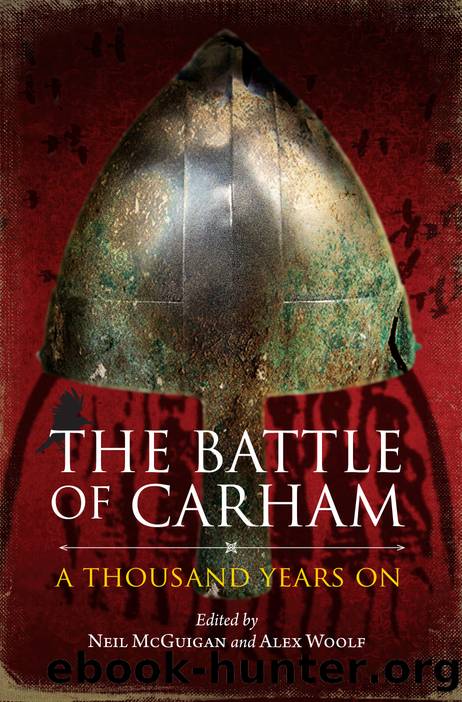The Battle of Carham by McGuigan Neil;Woolf Alex;

Author:McGuigan, Neil;Woolf, Alex;
Language: eng
Format: epub
Publisher: Birlinn
Acknowledgements
I would like to thank all those whose comments or assistance have, at various stages, contributed to the development of this article, in particular Alex Woolf, David Broun, John Hudson and Keri McGuigan.
____________
1 For Strathclyde, see B. T. Hudson âElech and the Scots in Strathclydeâ, Scottish Gaelic
Studies 15 (1988), 145â9; A. MacQuarrie, âThe Kings of Strathclyde, c. 400â1018â, in A. Grant and K. J. Stringer. (eds), Medieval Scotland: Crown, Lordship and Community: Essays Presented to G. W. S. Barrow (Edinburgh, 1998), 1â19; D. Broun, âThe Welsh Identity of the Kingdom of Strathclyde c. 900âc. 1200â, IR 55 (2004), 111â 80; C. Phythian-Adams, Land of the Cumbrians: A Study in British Provincial Origins, AD 400â1120 (Aldershot, 2006); and most recently T. Clarkson, Strathclyde and the Anglo-Saxons in the Viking Age (Edinburgh, 2014); F. Edmonds, âThe Emergence and Transformation of Medieval Cumbriaâ, SHR 93 (2014), 195â216 and âThe Expansion of the Kingdom of Strathclydeâ, Early Medieval Europe 23 (2015), 43â66. For the Norse of the southern Northumbria/Danelaw, where the upsurge has been even more intense, it is impossible to summarise fairly in a note. For important general works, see A. P. Smyth, Scandinavian York and Dublin: The History and Archaeology of Two Related Viking Kingdoms, 2 vols (Dublin, 1979); P. Sawyer, Anglo-Saxon Lincolnshire (Lincoln, 1998); D. M Hadley, The Northern Danelaw: Its Social Structure, c. 800â1100 (London, 2000); C. Etchingham, âNorth Wales, Ireland and the Isles: The Insular Viking Zoneâ, Peritia: Journal of the Medieval Academy of Ireland 15 (2001), 145â87; B. Hudson, Viking Pirates and Christian Princes: Dynasty, Religion and Empire in the North Atlantic (Oxford, 2005); D. M. Hadley, The Vikings in England: Settlement and Culture (Manchester, 2006); C. Downham, Viking Kings of Britain and Ireland: The Dynasty of Ãvarr to AD 1014 (Edinburgh, 2007); D. Griffiths, Vikings of the Irish Sea (Stroud, 2010); M. Townend, Viking Age Yorkshire (Pickering, 2014).
2 For instance, in D. Rollasonâs very good Northumbria, 500â1100: Creation and Destruction of a Kingdom (Cambridge, 2003), the bookâs forty-four-page chapter on the Viking Age gives them only a paragraph, at p. 249. The fullest treatments on our topic are D. Whitelock,âThe Dealings of the Kings of England with Northumbriaâ, in P. Clemoes (ed.), The Anglo-Saxons: Studies in Some Aspects of their History and Culture Presented to Bruce Dickins (London, 1959), 70â88; W. E. Kapelle, The Norman Conquest of the North: The Region and its Transformation, 1000â1135 (London, 1979); R. Fletcher, Bloodfeud: Murder and Revenge in Anglo-Saxon England (London, 2002). However, there are many important observations in the works cited above, and in A. Woolf, From Pictland to Alba, 789â1070, The New Edinburgh History of Scotland 2 (Edinburgh, 2007). See also N. McGuigan, âÃlla and the Descendants of Ivarâ, NH 52 (2015), 20â34.
3 M. Blackburn, âExpansion and Control: Aspects of Anglo-Scandinavian Minting South of the Humberâ, in J. Graham-Campbell, R. Hall., J. Jesch and D. Parsons (eds), Vikings and the Danelaw: Select Papers from the Proceedings of the Thirteenth Viking Congress, Nottingham and York, 21â30 August 1997 (Oxford, 2001), 125â42, at 127.
Download
This site does not store any files on its server. We only index and link to content provided by other sites. Please contact the content providers to delete copyright contents if any and email us, we'll remove relevant links or contents immediately.
| General | Channel Islands |
| England | Northern Ireland |
| Scotland | Wales |
Room 212 by Kate Stewart(4718)
The Crown by Robert Lacey(4557)
Endurance: Shackleton's Incredible Voyage by Alfred Lansing(4475)
The Iron Duke by The Iron Duke(4099)
The Rape of Nanking by Iris Chang(4004)
Killing England by Bill O'Reilly(3891)
Joan of Arc by Mary Gordon(3767)
Say Nothing by Patrick Radden Keefe(3701)
I'll Give You the Sun by Jandy Nelson(3254)
Shadow of Night by Deborah Harkness(3161)
Hitler's Monsters by Eric Kurlander(3144)
Blood and Sand by Alex Von Tunzelmann(3041)
Mary, Queen of Scots, and the Murder of Lord Darnley by Alison Weir(3037)
Darkest Hour by Anthony McCarten(3009)
Margaret Thatcher: The Autobiography by Thatcher Margaret(2963)
Eleanor & Park by Rainbow Rowell(2927)
Red Famine: Stalin's War on Ukraine by Anne Applebaum(2806)
Book of Life by Deborah Harkness(2705)
The One Memory of Flora Banks by Emily Barr(2674)
